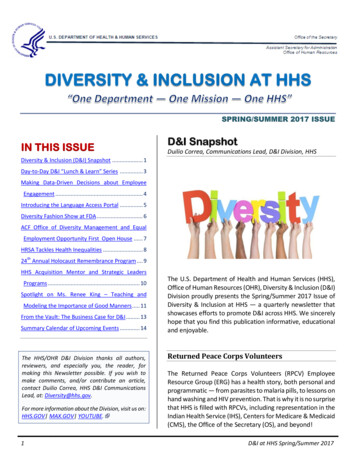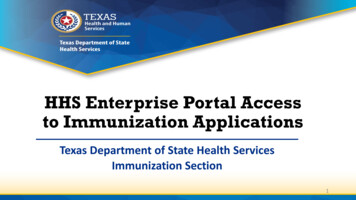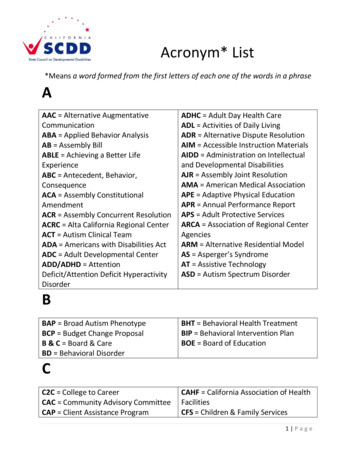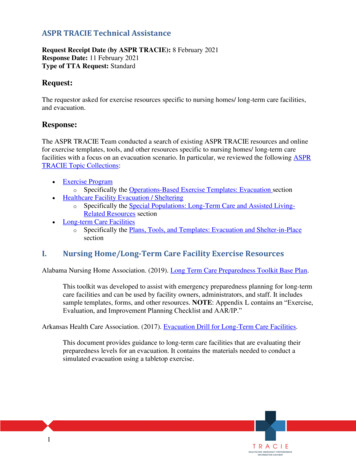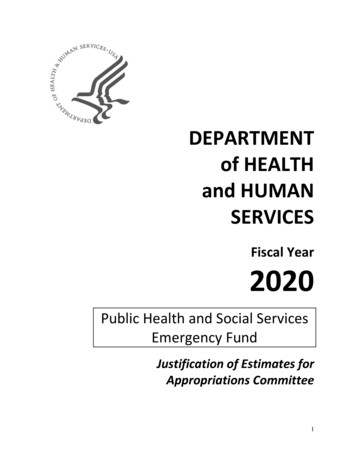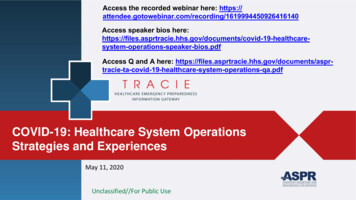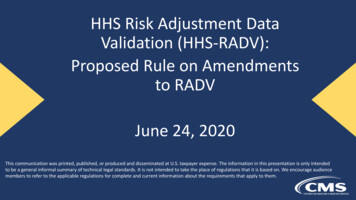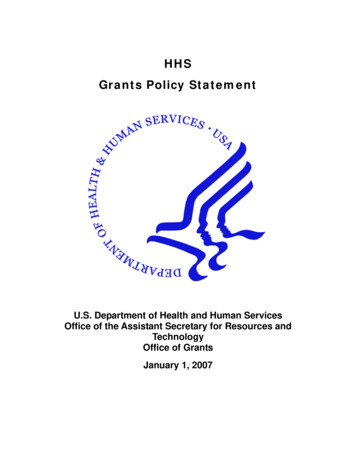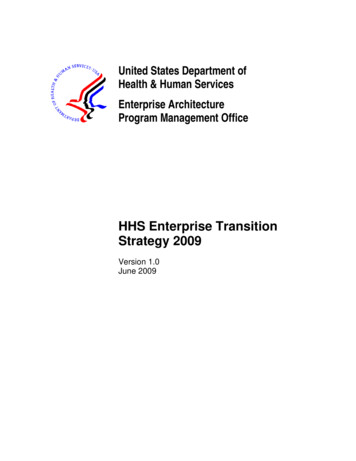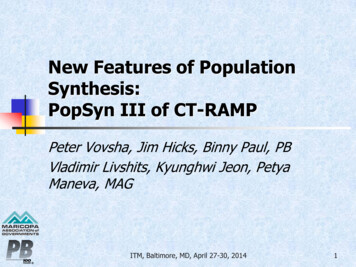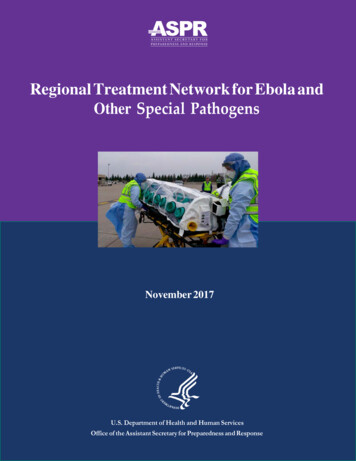
Transcription
Regional Treatment Network for Ebola andOther Special PathogensNovember 2017U.S. Department of Health and Human ServicesOffice of the Assistant Secretary for Preparedness and Response
Table of ContentsExecutive Summary. 2Purpose of the Report . 2Background. 2Section I: Regional Treatment Network Approach . 3Progression from Interim Guidance to the Regional Treatment Network . 3Four Tiers in the Regional Treatment Network . 4Patient Decision Algorithm for the Regional Treatment Network . 7Section II: Oversight and Financing for the Regional Treatment Network . 7Regional Treatment Network Funding Strategy . 7Section III: The State of Preparedness .10Regional Treatment Network Performance Measurement Strategy .11Progress and Capabilities by Tier .15Health Care Delivery System-Level Readiness .19Section IV: Planning and Future Considerations.23Hospital Preparedness Program (HPP) and National Ebola Training and Education Center(NETEC) Plans in Support of the Regional Treatment Network.23Ongoing HHS Ebola Response Improvement Plan Activities .24Future Considerations .25Appendix A: HPP Ebola Preparedness Measures Year One Results .26The Ebola Measures .26Year One (2015-2016) Results .27HPP Ebola Performance Measures Glossary.311
Executive SummaryPurpose of the ReportThis report, prepared by the Department of Health and Human Services (HHS), Office of theAssistant Secretary for Preparedness and Response (ASPR), Office of EmergencyManagement’s Division of National Healthcare Preparedness Programs, is in response to arequest by the House Committee on Appropriations in House Report 114-699 accompanyingH.R. 5926, the Departments of Labor, Health and Human Services, and Education, and RelatedAgencies Appropriations Bill, 2017:Regional Treatment Centers —The Committee is aware that HHS has created a regionaltreatment network for future infectious disease outbreaks through a tier system usingEbola funds. The Committee requests a report on the Department’s plans, includingfunding and timetables, for each tier outlining capabilities for infrastructure, training, andother key parameters, such as waste management. HHS should make a public versionof the report available on the HHS website.BackgroundBeginning in March 2014, West Africa experienced the largest Ebola virus disease outbreak onrecord. Unlike many smaller previous outbreaks of Ebola, this outbreak spread to multipleAfrican countries and caused 28,616 suspected, probable, and/or confirmed human cases. 1 InAugust 2014, the first American patient with Ebola was flown to the United States (U.S.) fortreatment. Additional patients were subsequently medically evacuated to the U.S. and tworeturned travelers were diagnosed and treated in Dallas, Texas, and New York City, New York.These experiences, and the secondary infections of two health care workers in a Dallashospital, identified opportunities to improve preparedness for and treatment of suspected andconfirmed patients with Ebola. In response, Congress appropriated emergency supplementalfunding in fiscal year (FY) 2015, in part to ensure that the health care system would beadequately prepared to respond to future Ebola outbreaks. In doing so, Congress directed HHSto develop a regional approach to caring for future patients with Ebola.Building upon a state- and jurisdiction-based tiered hospital approach and meeting Congress’regional directive, ASPR worked to develop a nationwide, regional treatment network for Ebolaand other special pathogens, which balances geographic need, considers differences ininstitutional capabilities, and accounts for the potential need to care for a patient with Ebola.The Department’s statutory authority for implementing this regional approach is derived fromTitle VI of Division G of the Consolidated and Continuing Appropriations Act, 2015, and section311 of the Public Health Service Act, as amended. The funding provided through the ASPRHospital Preparedness Program (HPP) Ebola Preparedness and Response Activities FundingOpportunity Announcement (FOA) cooperative agreement is intended to ensure that thenation’s health care system is ready to safely and successfully identify, isolate, assess,transport, and treat patients with Ebola or patients under investigation for Ebola, and that it iswell prepared for a future Ebola or other special pathogen outbreak. While the focus has been1As of April 13, 2016, which marks the end of updated case counts after the World Health Organization terminated the Public HealthEmergency of International Concern.2014 Ebola Outbreak in West Africa - Case Counts, Centers for Disease Control and 2014-west-africa/case-counts.html. Accessed May 3, 2017.2
preparedness for Ebola, it is likely that preparedness for other novel, highly pathogenic diseaseswill also be enhanced through these activities.“While the focus is on Ebola preparedness and response, it is likely that other novel, highly infectiousdiseases will also be enhanced through Ebola-related activities. The preparatory work funded throughthe (HPP) initiative has led to the beginning stages of the establishment of an in-state infectiousdisease system that includes a network of assessment hospitals, EMS/inter-facility transport services,and health care coalition.” (HPP awardee)Since 2015, the HPP Ebola Preparedness and Response Activities cooperative agreement hasprovided significant support to build the regional tiered network from a framework on paper to aprepared, functional system of care for Ebola and other special pathogens; however, it isimportant to note that the current capacity of this system is not likely to be sufficient for manytypes of infectious disease outbreaks (e.g., pandemic influenza and other respiratorypathogens).Section I: Regional Treatment Network ApproachProgression from Interim Guidance to the Regional Treatment NetworkIn December 2014, HHS released its initial Interim Guidance for U.S. Hospital Preparedness forPatients under Investigation or with Confirmed Ebola Virus Disease: A Framework for a TieredApproach 2, which outlined the different roles U.S. acute health care facilities could play inpreparing to identify, isolate, and evaluate patients with possible Ebola or to treat patients withconfirmed Ebola. These roles included serving as Ebola treatment centers, assessmenthospitals, and frontline health care facilities. Beginning in fall 2014, hospitals that had beenassessed by a Centers for Disease Control and Prevention (CDC)-led Rapid EbolaPreparedness (REP) team were designated by state health officials to serve as Ebola treatmentcenters. HPP staff participated in REP team assessments of potential Ebola treatment centersduring that time.Experience with patients with Ebola in the U.S. has shown that care of such individuals isclinically complex, requiring highly skilled health care providers and technologically-advancedcare. This led Congress, experts, and key health stakeholder groups to suggest that,subsequent to the interim guidance, care for patients with Ebola should be concentrated in asmall number of facilities. At the same time, however, a patient may present at any U.S. healthcare facility with any number of symptoms, exposures, or travel histories; therefore, all of thenation’s acute care facilities must be prepared to identify, isolate, and provide initial treatment toone or more simultaneous clusters of patients with Ebola until they can be transferred to afacility that can provide a more thorough assessment and/or definitive care. To that end, HHSbuilt upon the interim approach that focused on state- and jurisdiction-based tiered hospitals todevelop a strategy for a nationwide, regional treatment network for Ebola and other infectiousdiseases, which balances geographic need, differences in institutional capabilities, andaccounts for the potential risk of needing to care for a patient with Ebola.2Centers for Disease Control and Prevention (CDC). Interim Guidance for U.S. Hospital Preparedness for Patients underInvestigation (PUI) or with Confirmed Ebola Virus Disease (EVD): A Framework for a Tiered Approach. Available aring/hospitals.html. Updated August 28, 2015.3
Four Tiers in the Regional Treatment NetworkThe regional tiered approach allows for each of HHS’ 10 regions to augment preparedness andresponse coverage across the spectrum of required capabilities, while also strategicallyconcentrating resources at regional Ebola and other special pathogen treatment centers tomaximize the impact of federal funding and minimize the risk of exposure to a highly infectiousdisease like Ebola.Map of the U.S. displaying thelocations of 63 state or jurisdictionEbola treatment centers, 10regional Ebola and other specialpathogen treatment centers, and a400 mile radius of each of theregional treatment centers. Mapdate 8/8/2017. Map produced byASPR Division of Fusion. Datasources: CDC, ESRI, HHS, HSIP.Figure 1: Regional Ebola Treatment NetworkThe HHS regional framework for the tiered approach designates four roles for health carefacilities: frontline health care facilities, Ebola assessment hospitals, Ebola treatment centers,and regional Ebola and other special pathogen treatment centers (see Figure 1). To implementthe approach, state and local public health officials collaborated with private health care systemstakeholders to designate health care facilities across the state and in the regions to serve inone of these four roles. Aligned to the HHS framework and guidance, the nationwide regionaltreatment network for Ebola and other infectious diseases currently contains the following: 4Regional Ebola and other special pathogen treatment centers that can be ready withineight hours to receive a patient with confirmed Ebola from their region, across the U.S., ormedically-evacuated from outside of the U.S., as necessary. These hospitals haveenhanced capacity to care for other highly infectious diseases. The HPP-financed regionalEbola and other special pathogen treatment centers are:
34Region 1: Massachusetts Department of Public Health in partnership withMassachusetts General Hospital (Boston, Massachusetts);Region 2: New York City Department of Health and Mental Hygiene inpartnership with New York City Health and Hospitals Corporation/HHC BellevueHospital Center (New York City, New York);Region 3: Maryland Department of Health and Mental Hygiene in partnershipwith Johns Hopkins Hospital (Baltimore, Maryland);Region 4: Georgia Department of Public Health in partnership with EmoryUniversity Hospital and Children’s Healthcare of Atlanta/Egleston Children’sHospital (Atlanta, Georgia);Region 5: Minnesota Department of Health in partnership with University ofMinnesota Medical Center (Minneapolis, Minnesota);Region 6: Texas Department of State Health Services in partnership withUniversity of Texas Medical Branch at Galveston (Galveston, Texas);Region 7: Nebraska Department of Health and Human Services in partnershipwith Nebraska Medicine – Nebraska Medical Center (Omaha, Nebraska);Region 8: Colorado Department of Public Health and Environment in partnershipwith Denver Health Medical Center (Denver, Colorado);Region 93: California Department of Public Health in partnership with CedarsSinai Medical Center (Los Angeles, California); and,Region 10: Washington State Department of Health in partnership withProvidence Sacred Heart Medical Center and Children’s Hospital (Spokane,Washington).State or jurisdiction Ebola treatment centers that can safely care for patients with Ebolain the event of a cluster of patients with Ebola that overwhelms the regional Ebola and otherspecial pathogen treatment center. Clinical judgment, available logistical resources, andpatient preference may indicate that the patient should receive treatment at a state orjurisdiction Ebola treatment center rather than be transferred to a regional Ebola and otherspecial pathogen treatment center.Assessment hospitals that can receive and isolate patients under investigation for Ebolaand care for the patient until a diagnosis of Ebola can be confirmed or ruled out and untildischarge or transfer is completed.Frontline health care facilities that are prepared to rapidly identify and isolate patients whomay have Ebola. These facilities must be able to promptly inform the hospital/facilityinfection control program and state and local public health agency and assessment hospitalsor Ebola treatment centers (as necessary) to arrange patient transfer. Frontline health carefacilities are also responsible to provide stabilizing treatment, per the Emergency MedicalTreatment and Labor Act (EMTALA) requirements. 4Region 9 did not have a Part B awardee in budget period one. Cedars-Sinai was named the Region 9 awardee in June 2016.The Emergency Medical Treatment and Labor Act (EMTALA) (1986).5
Table 1: Regional Treatment Network Capabilities Required by TierTier and Count Role and Capabilities Required 56Frontline health carefacility (4,845) Ebola assessmenthospital (217) Ebola treatment center(63) Regional Ebola and otherspecial pathogentreatment centers (10)Safely receives and isolates a patient with possible Ebola;Provides immediate laboratory evaluation and coordinates Ebola testing;Has enough Ebola PPE for up to 96 hours of evaluation and care for patient(s)under investigation for Ebola;Has staffing plans to support 96 consecutive hours of clinical care. All staffinvolved in or supporting patient care are appropriately trained for their roles;Cares for a patient for up to 96 hours (including evaluation and management ofalternative diagnoses) until Ebola diagnosis is confirmed or ruled out;Secured the services of a waste management vendor capable of managing andtransporting Category A infectious substances; and,Coordinates with necessary stakeholders (including transport providers) totransport a patient to an Ebola treatment center, depending on the status of thepatient and the capacity of the Ebola assessment hospital.Collaborates with the state and local public health agency, emergency medicalservices provider(s) on the development of interfacility transportation plans;Safely receives and isolates a patient with confirmed Ebola;Cares for patients with Ebola for duration of illness;Has enough Ebola PPE for at least seven days of care (will restock as needed);Has sustainable staffing plan to manage several weeks of care. Staff memberswho will be involved in managing the patient are familiar with the clinicalprotocols for management of patients with Ebola;Secured the services of a waste management vendor capable of managing andtransporting Category A infectious substances; and,CDC Ebola Response Teams are ready to deploy to provide assistance asneeded.These hospitals are part of the network of Ebola treatment centers across the countrybut have what HHS calls "enhanced capabilities." The selected hospitals are requiredto do the following: Quickly identifies and isolates patients with possible Ebola;Notifies the hospital/facility infection control program, other appropriate facilitystaff, state and local public health agencies, and assessment hospitals or Ebolatreatment centers (as necessary) to arrange patient transfer;Has enough Ebola personal protective equipment (PPE) for at least 12–24 hoursof care; and,Provides stabilizing treatment per EMTALA requirements.Accept patients within eight hours of notification;Be able to treat simultaneously at least two patients with Ebola for duration ofillness;Have respiratory infectious disease isolation capacity or negative pressurerooms for at least 10 patients;Conduct trainings and exercises each quarter;Be able to treat pediatric patients with Ebola or another highly infectious diseaseor partner with a nearby facility to do so;Be able to safely handle waste from such patients; and,Frontline and assessment hospital counts are current as of 2015-2016 data. Ebola treatment center and regional Ebola and otherspecial pathogen treatment center counts reflect July 2017 data. HPP will have updated hospital counts for all tiers of the regionaltreatment network following the validation and analysis of 2016-2017 reported data. Final 2016-2017 performance data was duefrom awardees to ASPR in September 2017. ASPR’s validation and analysis of the data will be complete by late 2017.5Interim Guidance for U.S. Hospital Preparedness for Patients under Investigation (PUI) or with Confirmed Ebola Virus Disease(EVD): A Framework for a Tiered Approach. ng/hospitals.html.6HPP Ebola Preparedness and Response Activities ity.html?oppId 274709.6
Receive annual readiness assessment from the National Ebola Training andEducation Center.Patient Decision Algorithm for the Regional Treatment NetworkIn addition to the overarching framework and guidance outlined in the table above, HHSdeveloped an Ebola patient decision algorithm that helps stakeholders across the regionaltreatment network decide where a patient under investigation for Ebola should be screened,evaluated, and treated based on factors such as availability of logistical resources (e.g.,available beds and transport resources), facility capacity, and clinical judgement. This Ebolapatient decision algorithm provides critical guidance on how the regional treatment tiers, asdescribed above in Table 1, should work together to safely and successfully treat a patient withEbola.A visual depiction and simplification of the algorithm is shown in Figure 2, below.Flow chart that depicts first,second, and third preferences fortreatment of a confirmed patientwith Ebola among the regionaltreatment network tiers.Figure 2: Ebola Patient Decision Algorithm DepictionSection II: Oversight and Financing for the Regional TreatmentNetworkRegional Treatment Network Funding StrategyIn response to the 2014-2015 Ebola outbreak, Congress appropriated 5.4 billion in emergencysupplemental funding to a number of federal agencies, including HHS, which have a key role inresponse and preparedness activities. This emergency Ebola funding was directed towardssupporting international response, research and development, and the U.S. domestic response.Within the federal government, HHS is primarily responsible for overseeing domesticpreparedness and response for Ebola and other emerging infectious disease outbreaks. 7 Of the 5.4 billion in total emergency funding, 259.7 million was directed to HHS for Ebolapreparedness and response activities in support of the regional treatment network. HHS’standup of the regional treatment network was a key feature of the U.S. domestic response.7National Response Framework and Public Health Service ority/Pages/default.aspx.7
Table 2: Regional Treatment Network FundingFunding TypeFunding AmountGoal of FundingHPP Ebola Part A 181,171,000Support state- or jurisdiction-level preparedness forfrontline health care facilities, assessment hospitals,state or jurisdiction Ebola treatment centers, andhealth care coalitions, in addition to emergencymedical services (EMS) and the overall health caresystem.HPP Ebola Part B 32,500,000Establishment of an Ebola and other special pathogentreatment center (one per each of the 10 HHSregions).National Ebola Trainingand Education Center(NETEC) 24,000,000Establish a national training and education center toincrease the competency of health care and publichealth workers and the capability of health carefacilities to deliver safe, efficient, and effective care topatients with Ebola and other special pathogens.Health Care SystemTraining Simulation andQuarantine Center forEbola and Other SpecialPathogens 20,000,000Establish a training, simulation, and quarantine centerfor Ebola and other special pathogens.ASPR TechnicalResources, AssistanceCenter, and InformationExchange (TRACIE) 2,000,000Support ASPR TRACIE to develop and disseminatetopic collections and resources specific to Ebola (e.g.,EMS checklist for Ebola preparedness), which areavailable to all health care stakeholders.Total 259,671,000Jointly funded by ASPRand CDCAlthough building on the all-hazards health care preparedness and response capacity andcapabilities developed since 2002 through ASPR’s HPP, the U.S. regional treatment network forEbola is primarily supported through emergency supplemental funding. Through the EbolaPreparedness and Response Activities cooperative agreement, ASPR HPP has awarded 213.7 million for the establishment of the regional treatment network for Ebola and otherspecial pathogens. HHS has also used the emergency Ebola funding to establish the NationalEbola Training and Education Center (NETEC) and support the development of the Health CareSystem Training Simulation and Quarantine Center for Ebola and Other Special Pathogens.The funding directly supports the development of key capabilities needed for response to anEbola outbreak in the U.S.ASPR purposefully distributed the vast majority of the supplemental funding in the first year ofthe five-year HPP project period to encourage a rapid buildup of key capabilities across eachfacility tier. The remaining years of supplemental and competitive funds are intended to sustainand maintain the regional treatment network’s preparedness and response capabilities. FY2019 marks the final year in which emergency funds provided for Ebola will be available tosupport the regional treatment network. Per the cooperative agreements with HPP awardees,ASPR’s staff and subject matter experts have substantial involvement with Ebola preparednessactivities that is above and beyond routine grant administration. ASPR’s active participationamplifies the impact of Ebola preparedness activities; for example, HPP Field Project Officersparticipate in NETEC site assessment visits and also monitor outcomes from the HPP-requiredexercises.8
The HPP Ebola preparedness and response funding for the regional tiered approach are splitinto two parts: Part A and Part B, which are described below.Part A: Health Care System Preparedness for EbolaASPR allocated Part A funding to all current 62 HPP awardees (the 50 states, the District ofColumbia, three directly-funded cities, and all U.S. territories and freely associated states) overa five-year project period. HPP allocated 181.2 million in Part A funding to support state- orjurisdiction-level preparedness for frontline health care facilities, assessment hospitals, state orjurisdiction Ebola treatment centers, and health care coalitions, in addition to emergencymedical services (EMS) and the overall health care system. ASPR’s Part A funding strategyincluded a base amount population Ebola risk formula that determined funding levels foreach awardee, which ranged from 203,000 to 15.8 million, with an average award of 2.9million. The risk portion was based on the percentage of returning travelers from impactedcountries and reflected West African diaspora population centers and jurisdictions withenhanced airport screenings. 8 Through Part A, jurisdictions could use a portion of the fundingto compensate health care facilities retroactively for Ebola preparedness activities undertakensince July 2014; build additional capabilities to ensure that the nation’s health care system andhealth care workers are ready to safely and successfully identify, isolate, assess, transport, andtreat patients under investigation for Ebola or confirmed to have Ebola; and be well prepared fora future Ebola-like event. HPP requires that all entities (Ebola treatment centers, assessmenthospitals, and health care coalitions) receiving funding through Part A establish a plan tomaintain their readiness to care for a patient with Ebola for the duration of the full five-yearproject period (May 2015-May 2019) through annual staff trainings and exercises andsustainment of Ebola PPE.Part B: Development of a Regional Treatment Network for Ebola Patient CareFor Part B, ASPR competitively awarded funding to 10 HPP awardees who partnered with ahealth care facility (or facilities) within their jurisdictions to develop regional Ebola and otherspecial pathogen treatment centers (one in each of the 10 HHS regions). Part B funding totaled 32.5 million, with 3.25 million in funding allocated to each of the 10 Part B awardees over thecourse of the five-year project period. Each regional Ebola and other special pathogentreatment center serves as a regional asset and is required to accept patients from outside of itsjurisdiction. The regional Ebola and other special pathogen treatment centers have enhancedpreparedness capabilities to ensure that they are the leading provider of care and treatment forpatients with Ebola in the U.S. and that they have the capabilities needed to manage other highcontainment infectious diseases in the future. 9 Part B awardees also lead the coordinatedregional planning effort for all jurisdictions within their region, including agreements and plansfor the inter-facility transfer of patients within the region.Of the total Part B funding amounts, HPP provided at least 2.25 million during the first year andallocated 250,000 in the four subsequent years for each regional Ebola and other specialpathogen treatment center to sustain and maintain capabilities. The funding is initially receivedby the awardee, who then directs no less than 90 percent of funds to their regional Ebola andother special pathogen center hospital partners. Through the funding agreement, HPP requires8High-risk jurisdictions include: California, Chicago, Connecticut, District of Columbia, Georgia, Maryland, Massachusetts,Minnesota, New Jersey, New York, New York City, North Carolina, Ohio, Pennsylvania, Rhode Island, Texas, Virginia, andWashington. Risk is based on the percentage of returning travelers from affected countries and reflects West African diasporapopulation centers and jurisdictions with enhanced airport entrance screenings.9Hospital Preparedness Program (HPP) Ebola Preparedness and Response Activities ity.html?oppId 274709.9
the Part B awardee to provide lead support for regional planning for the development of theregional network for Ebola care in addition to developing, supporting, and maintaining centercapabilities to provide immediate and effective care to a patient with Ebola.National Ebola Training and Education Center (NETEC)Key lessons learned from the initial health care system response to Ebola cases include theimportance of protecting the health care workforce and the critical role of early case recognitionin improving outcomes, given the clinical complexity of caring for a patient with Ebola. Buildingon these fundamental lessons, ASPR and CDC partnered to allocate 24 million in emergencyEbola funds to establish the NETEC. The NETEC is funded through a five-year CDC and ASPRjoint cooperative agreement that began in 2015. The NETEC uses HHS funding to support theregional treatment network by leveraging public and private expertise to share promisingpractices and scale activities to address Ebola. More information about NETEC is provided in aseparate section below.Health Care System Training Simulation and Quarantine Center for Ebola and OtherSpecial PathogensThrough evaluation of the domestic Ebola response, HHS also found a significant gap inquarantine capacity in the U.S. health care delivery system. The U.S. lacked adequate space tomonitor individuals coming to the U.S. who may have been exposed to Ebola patients fromimpacted regions. To close this gap, HPP awarded nearly 20 million to the University ofNebraska Medical Center (UNMC) for a training, simulation, and quarantine center. Uponcompletion in 2018, this center will provide simulated clinical training to federal responders (theNational Disaster Medical System and the U.S. Public Health Service Commissioned Corps)and now has the capacity to quarantine up to 20 individuals simultaneously, if necessary, on theUNMC campus.10
Section III: The State of PreparednessRegional Treatment NetworkPerformance Measurement StrategyPrior to the 2014-2015 Ebola outbreak, theU.S. did not have a systematic approach topreparing for and responding to an outbreakof a highly infectious special pathogen.Through HHS’ investments, specifically theHPP Ebola Preparedness and ResponseActivities cooperative agr
Providence Sacred Heart Medical Center and Children's Hospital (Spokane, Washington). State or jurisdiction Ebola treatment centersthat can safely care for patients with Ebola in the event of a cluster of patients with Ebola that overwhelms the regional Ebola and other special pathogen treatment center.
